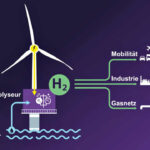Hydrogen: goals and ambitions
With the NWS, the German government is creating a coherent framework for action for the future production, transport, use and further use of hydrogen and thus for corresponding innovations and investments. It defines the steps that are necessary to contribute to achieving the climate targets, to create new value chains for the German economy and to further develop international energy policy cooperation. Against this background, the NWS pursues the following goals in particular:
Taking global responsibility
.
The German government is committed to Germany’s global responsibility for reducing greenhouse gas emissions. Our country can make a significant contribution to global climate protection by developing a market for hydrogen and aiming to establish hydrogen as a decarbonisation option.
Making hydrogen competitive
Under the current framework conditions, the production and use of hydrogen is not yet economically viable. In particular, the use of fossil fuels, for which the follow-up costs of CO2 emissions are currently not priced in, is still significantly cheaper. For hydrogen to become economically viable, we have to push ahead with cost degression in hydrogen technologies. A rapid international market ramp-up for the production and use of hydrogen is of great importance here, in order to drive technological progress and economies of scale and to have the necessary critical mass of hydrogen available in time for the conversion of the first areas of application. A particular focus is on areas that are already close to economic viability and where major path dependencies are avoided or which cannot be decarbonised in any other way, for example to avoid process emissions in the steel and chemical industries or in certain areas of transport. But we are also looking at parts of the heating market in the longer term.
Develop a “home market” for hydrogen technologies in Germany, pave the way for imports
As a first step for the market ramp-up of hydrogen technologies, a strong and sustainable domestic hydrogen production and hydrogen use – a “home market” – is indispensable. A strong domestic market also creates an important signalling effect for the deployment of hydrogen technologies abroad. The incentives for the market ramp-up of hydrogen technologies in Germany, and especially those for the construction and operation of electrolysers, will be designed in such a way that they are in line with the energy transition.
The German government foresees a hydrogen demand of approx.
of approx. 90 to 110 TWh by 2030. In order to cover part of this demand, generation plants of up to 5 TWh are to be built in Germany by 2030.
Germany by 2030, including the necessary offshore and onshore energy production. This corresponds to a green hydrogen production of up to 14 TWh 2 and a required renewable electricity quantity of up to 20 TWh. It must be ensured that the demand for electricity induced by the electrolysis plants does not lead to an increase in CO2 emissions as a result. As part of the monitoring of the national hydrogen strategy, the German government will also record the development of demand for green hydrogen in detail. For the period up to 2035, a further 5 GW will be added if possible, by 2040 at the latest.



